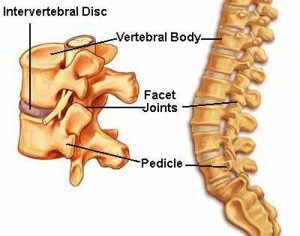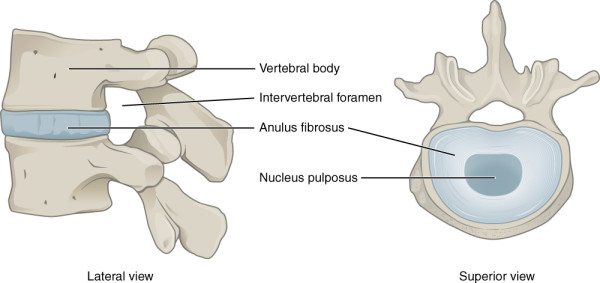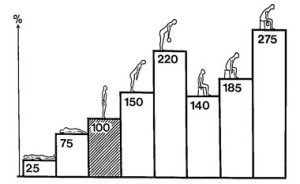Back Pain Series: NEVER Lift and Twist!
Over the years I have treated many patients experiencing significant and acute low back pain. It can be debilitating and fairly scary. When I ask them the cause of their pain, the answer usually entails some type of lift and twist. A few years ago, two patients were helping move a large fermenter that did not “pivot” well and BOTH had acute low back pain, difficulty walking and fear of movement after that incident. Other patients have had back pain from improper exercise form such as: chop lift, kettlebells and Cross Fit. And, as a PT in Colorado, there is one winter task that commonly brings patients into the clinic. What is it? Shoveling.
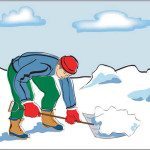 Shoveling? Really? Who hurts themselves shoveling snow? A lot of people. And, it’s not because they are weak or out of shape. Most people shovel by scooping up the snow (lift) and turning to dump it onto the side (twist). And, it’s a repetitive movement. Depending on the size of the driveway and depth of snow, it can take a LONG time to shovel a property. That’s a lot of lifting and twisting! But, no matter what the task or function, just remember: never lift and twist.
Shoveling? Really? Who hurts themselves shoveling snow? A lot of people. And, it’s not because they are weak or out of shape. Most people shovel by scooping up the snow (lift) and turning to dump it onto the side (twist). And, it’s a repetitive movement. Depending on the size of the driveway and depth of snow, it can take a LONG time to shovel a property. That’s a lot of lifting and twisting! But, no matter what the task or function, just remember: never lift and twist.
Here’s a little anatomy review to help make sense of this phrase.
The Spine, Discs and Facet Joints
Our spine is comprised of facet joints, vertebral bodies and intervertebral discs.
The facet joints guide movement in the spine. These facets slide, glide, open and close on each other to allow for forward bending, backward bending, side bending and rotation.
The discs have a few functions. They create and keep space between each body to allow a nerve to run through. They allow for movement at each level and attenuate or disperse force across the vertebral body and spine.
The intervertebral disc has two components: the annulus and the nucleus pulposus. The nucleus pulposus is a gel-like substance which allows for motion at the vertebral level. The nucleus loves water and gets its nutrition by imbibition. Imbib, bib what? It’s pretty cool how this works.
During the day, gravity and our body weight gently squeeze fluid out of the nucleus. This makes us a little shorter at night (seriously). When weight is taken off our spine (i.e. lying on our side or back), our discs become “thirsty” and fluid begins to flow into the nucleus from the vertebral body. This flow is called diffusion (remember diffusion is the act of a substance moving from a place of high concentration to low concentration). This diffusion is imbibition. And, we are actually taller in the morning than at night. (If you have healthy discs, measure yourself in the morning and then at night. I bet there’s a difference!)
The annulus is a fibrous ring that encapsulates or “hugs” the nucleus. This ring is made of several layers and each layer has fibers running in opposite diagonal patterns. Criss-cross your right fingers on top your left fingers. This is how the annular fibers line up. Now imagine several layers of that. This criss-cross pattern allows for a very stable annular ring. However, increased stability equals decreased mobility.
What is so dangerous about the lift and twist?
It puts our lumbar (low back discs) in a super vulnerable position!
With forward bending, backward bending and side bending, all of the fibers in the annular ring are able to resist the motion. All of them. That means 100%.
However, when you rotate, only 50% of the fibers in the annular ring are resisting the rotation. Only 50%! Additionally, the facets are moving in a manner and cause shear and compression (a really big squish) to the disc. This combo puts the disc in a vulnerable state. Functionally, this is usually not a big deal. We use rotation to look behind us or reach around and grab something. We don’t hang out at end-range rotation or repeat these functional movements several times in a row. It’s just a natural functional movement. But, what happens when we lift and then add rotation with some sort of load? Your back goes into panic mode!
Alf Nachemson, MD, PhD published a well-known study on the pressure inside the lumbar (low back) intervertebral discs. He measured various positions from lying on your back to sitting in a chair to bending over. Subsequent research has found his original pressure study to be consistent with data today.
- What position do you think has the lease amount of pressure on the disc?
- What position has the most?
The chart below is from Nachemson’s research. The chart is based on the percentage increase or decrease from a standing position (darkened column with 100).
Chart columns in order: lying on back, lying on side, standing, forward bending, forward bending with lifting a weight, sitting, sitting with slouched posture, sitting with lifting a weight.
Do you see it? Lifting and forward bending and lifting in a seated position increased the disc pressure by over 100%!
Remember, the annular fibers are all working with forward bending position and in a seated position. Add rotation with that lifting pressure and only 50% of the annular fibers are resisting the load.
Houston..we have a problem.
Lift with Twist Injury: What causes the back pain?
Common Scenarios in the Clinic
- Muscle guarding: your back muscles go into super-strong mode to protect the spine from any damage. This muscle pain can be extreme, create spasms and can cause “nerve-like” symptoms into your leg. (you’re hoping for this scenario)
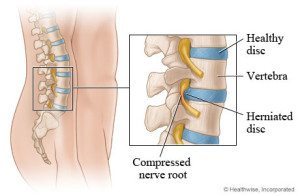 Disc herniation with muscle guarding: your back muscles try to protect the spine, but the load or number of repetitions trump the strength in the back. This allows the load to transfer to the disc. The annular ring tears a bit and some of the nucleus is able to sneak out. (this is not awesome, but better than scenario #3).
Disc herniation with muscle guarding: your back muscles try to protect the spine, but the load or number of repetitions trump the strength in the back. This allows the load to transfer to the disc. The annular ring tears a bit and some of the nucleus is able to sneak out. (this is not awesome, but better than scenario #3).- Disc herniation with muscle guarding and nerve encroachment: The leaky nucleus is now touching a nerve and we all know that is not a good thing.
Take Home Points
- NEVER Lift and Twist – with shoveling, exercise or moving heavy objects
- Lifting a weight or load increases disc pressure
- Rotation is the most vulnerable spinal movement on the intervertebral discs
- Lift + Twist = Back Injury Waiting to Happen
Here is a 1 minute video to quickly explain some safe lifting and shoveling mechanics.
© 2015 and Beyond. ALL BLOG CONTENT at duncansportspt.com by Lori Duncan PT
 Lori Duncan, DPT, MTC, CPT is a respected Physical Therapist, Manual Therapist and Pilates instructor in Lafayette, CO. Lori is passionate about preventive physical therapy and education and is a nationally recognized presenter. She can be reached at [email protected]. You can also follow Duncan Sports Therapy + Wellness on Facebook & Instagram for more free tips and information.
Lori Duncan, DPT, MTC, CPT is a respected Physical Therapist, Manual Therapist and Pilates instructor in Lafayette, CO. Lori is passionate about preventive physical therapy and education and is a nationally recognized presenter. She can be reached at [email protected]. You can also follow Duncan Sports Therapy + Wellness on Facebook & Instagram for more free tips and information.
References
Nachemson AL. Disc pressure measurements. Spine 1981;6:93–7


